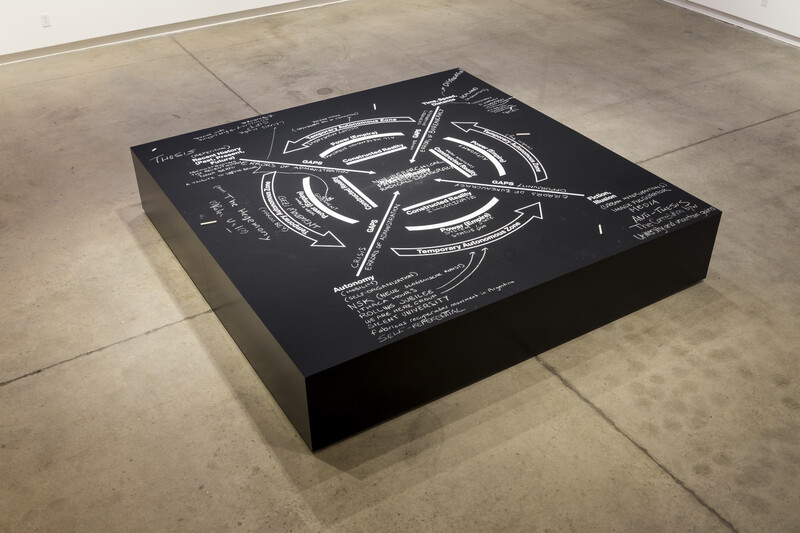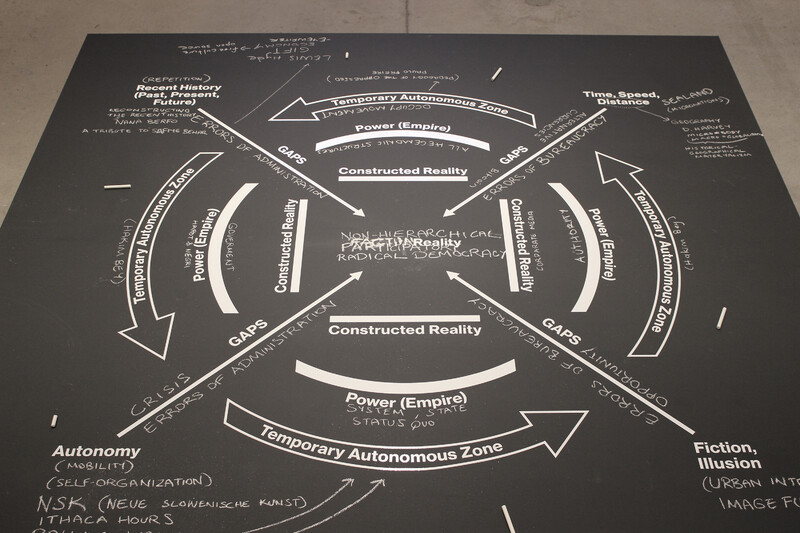
Ahmet Öğüt creates situations that shift contexts, allowing for new possibilities of interchange and alternative perspectives on continuity, in so doing expanding our perceptions, and as Öğüt states “finding ways of disrupting social protocols by making minor shifts in their most basic forms.”1 Öğüt’s ability to creatively identify these contextual gaps facilitates the public's agency in constructing their own participation. In his artistic practice, Öğüt sets a platform for critical discourse that is at once insightfully political, focusing on the global flux in geo-political, economic and social inequities, and culturally considered in its interpretation, using both humour and irony to reach his audience. There is also an unexpected quality to Öğüt’s work, a dislocation of the artistic frame that effectively opens the viewer to a peripheral-like vision, challenging our interpretation of cyclical-temporal address. This invitation initiates a temporal freedom to reconsider our role in society, and provides access to demonstrate these interwoven connections. Ironically, this dislocation of the artistic frame is more often than not, located historically and site-specifically, in a local context beyond that of the art world, mobilizing the art world as yet another form of mediation.
Strategies for Radical Democracy is the first solo exhibition of Turkish artist Ahmet Öğüt in Canada. The exhibition features seven key works dating from 2009 to the present, showcasing the range of Öğüt’s artistic practice across a variety of media including installation, intervention, video, and performance. The centerpiece of the exhibition is a raised platform structure (8’ x 8’) illustrating the artist’s theory titled Strategic Diagram for Non-hierarchical Participatory Radical Democracy. The diagrammatic structure functions as a way to analyze socio-political shifts and demarcate mediation. Öğüt identifies those that activate mediation, as “anyone who is trying or thinking about the possibilities of transforming the system.” This statement is the foundation through which the framework Öğüt has devised can be understood. The diagram is quadrant-divided and each forms a Constructed Reality built in service of a Power (Empire) that operates as a temporary autonomous zone and thus contains gaps as part of this shifting framework. The function of the framework is to provide a platform for non-hierarchical participatory radical democracy. Öğüt’s theories of Non-hierarchical Participatory Radical Democracy are delineated in his artistic practice as 1) Time, Speed, Distance; 2) Reconstructing Recent History; 3) Fiction/Illusion; and 4) Autonomy (Self-Organization). They are indicated in the four strategic zones of the diagram as well as in the physical structure positioned at the center of the gallery space. Viewers are invited to participate with their own theories by writing on the diagram with the chalk provided. The platform diagram provides a quasi-directional module for the exhibition by dividing the gallery into four corresponding zones, each wall indicating a zone, and each wall indicating works by Öğüt which reference its respective zone.
—Rhonda Corvese
Strategies for Radical Democracy
Curated by Rhonda Corvese
- Artist
- Ahmet Öğüt
- Curator
- Rhonda Corvese
Matthew Hoffman



The Blackwood
University of Toronto Mississauga
3359 Mississauga Road
Mississauga, ON L5L 1C6
[email protected]
(905) 828-3789
The galleries are currently closed.
Facebook | Twitter | Instagram
Sign up to receive our newsletter.
The Blackwood is situated on the Territory of the Mississaugas of the Credit, Seneca, and Huron-Wendat.
